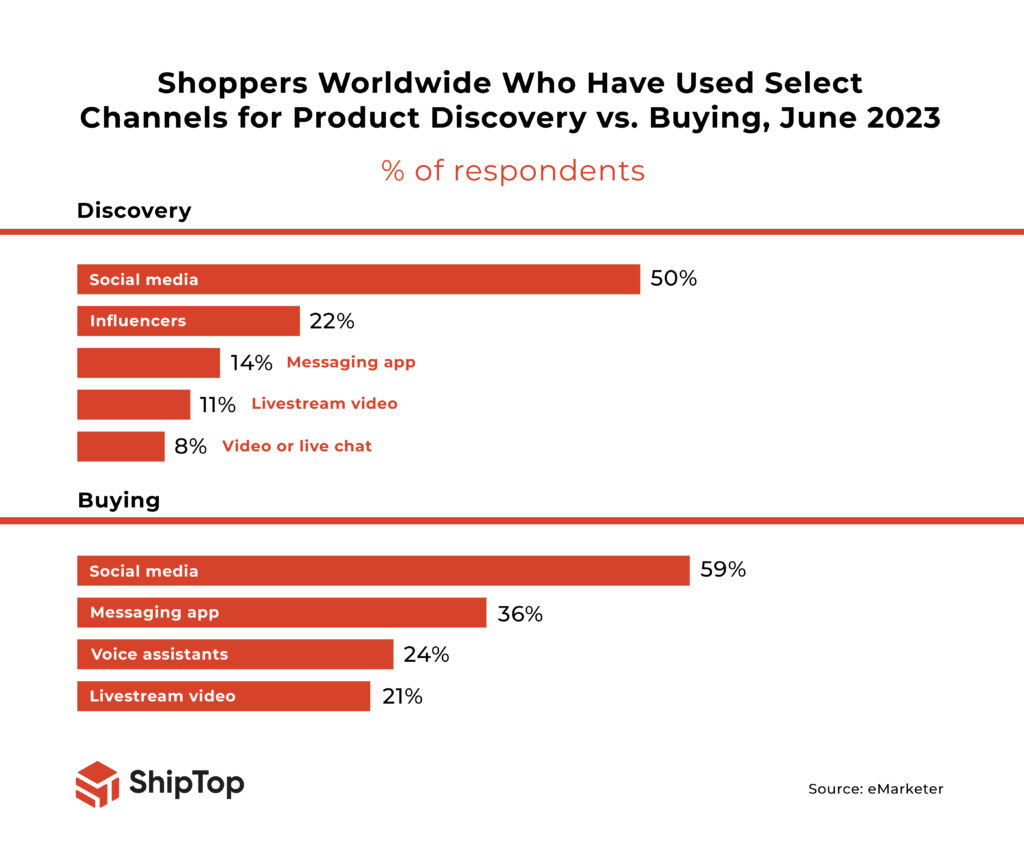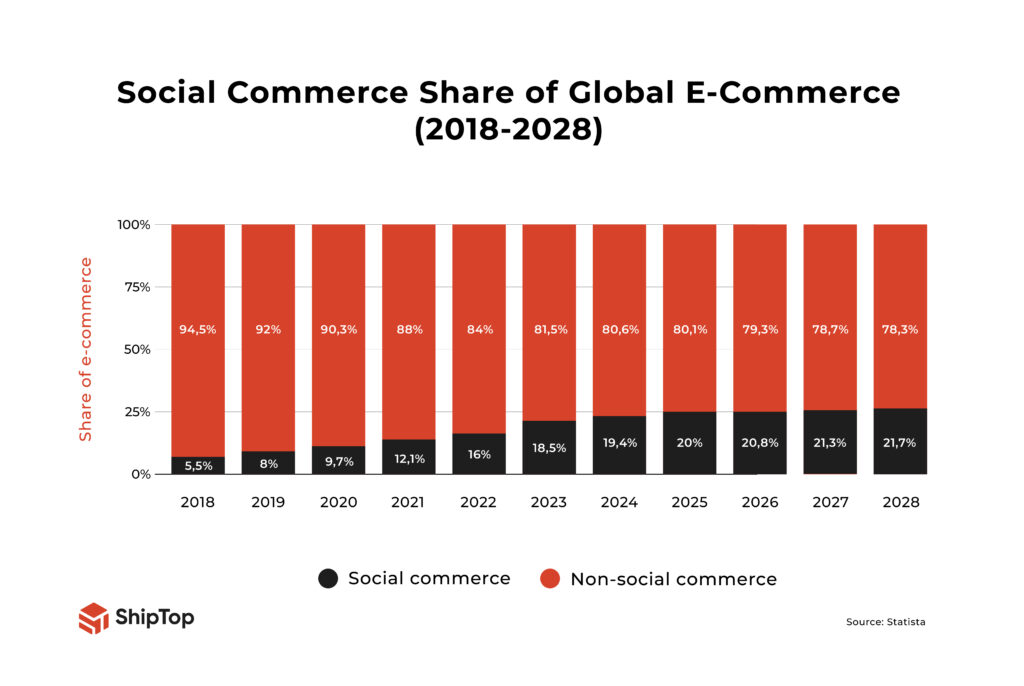Is Your Fulfillment Strategy Ready for Social Commerce?
Despite various channels and many ways to find new products, 27% of consumers today prefer social media.
What started as a bunch of platforms for connecting with friends, now also serves as major shopping hubs with millions of users – and nobody knows it better than eCommerce brands.
One in four potential customers in retail now use social media to shop; and for the revenue, it’s set to reach $6.2 trillion by 2030. With just a few clicks, people can buy products without leaving their favorite social media platforms – but as convenient and exciting social commerce is for customers, as challenging it is for retailers, specifically in terms of order fulfillment.
In this article, we’ll explore how businesses can adapt their fulfillment processes to meet the demands of social commerce with the help of a professional 3PL provider.

What is social commerce & why it is becoming so popular
Is there anything better these days than coming across a post from an influencer you admire, showcasing a new product you didn’t know you needed until that very moment?
The best part is that you can buy it instantly, without leaving the app. This scenario is the essence of social commerce, and it’s becoming increasingly popular as in the US alone, there are already 110.4 million social buyers.
Social platforms like TikTok, Facebook and Instagram have made this great consumer scenario possible for its users enabling brands to sell directly to consumers in many markets due to their global reach and localized features.
Technically, social commerce means selling products directly on social media. It’s a blend of online shopping and social media. The whole shopping process, from finding a product to paying for it, happens on social media. This gives online businesses more reach and provides an easy, convenient way for customers to shop.
So now social media platforms are as much a marketplace as a website for sellers.

Quick overview of the main platforms:
- TikTok: Rapid user growth, with 48.8 million U.S. users expected by 2025.
- Facebook: Preferred by 89% of marketers for social commerce; 62% of recent U.S. social buyers made their last purchase on Facebook.
- Instagram: Used by nearly 26% of the global population over the age of 13 for shopping.
- Pinterest: 465 million monthly users; 97% of searches are unbranded, ideal for product discovery.
Read more: TikTok For Shopify Success 2024: Converting Views into Ecommerce Sales
Social Commerce vs. eCommerce: What’s the difference in terms of fulfillment
Social commerce and eCommerce are both ways to shop online, but they have some key differences, particularly in how retail brands manage order processing and shipping logistics.
In traditional eCommerce, orders usually come in at a more or less steady pace, making the whole fulfillment process pretty organized and predictable. When people shop on eCommerce platforms, they often know exactly what they want, which makes their buying patterns easier to predict. This helps businesses forecast demand better and keep their inventory in check. Plus, big sales events like Black Friday or Cyber Monday are scheduled and happen at set times. This allows companies to prepare and adjust their inventory and staffing levels in advance.
Meanwhile, social commerce introduces a fundamentally different set of fulfillment dynamics. Social commerce means that order volumes can surge unexpectedly due to viral social media posts, hashtags or endorsements by popular influencers (even friends or trusted people). For example, 49% of social commerce shoppers being influenced by an influencer’s recommendation, a single influencer’s endorsement can lead to a sudden spike in orders.
The nature of social commerce is best described by impulsive buying behavior, like instant purchases that often lead to sudden spikes in order volumes. Of course, there is nothing better than impulsive purchases for brands you may say, and you’re right! At the same time, however, it makes demand forecasting highly challenging and requires fulfillment operations to be highly flexible.
There are also other features of social commerce that impact fulfillment:
- Due to real-time interactions on social media, customers want their orders quickly, so brands need to be able to ship products faster.
- If a brand faces high engagement and lots of reviews on some social platform, it can cause demand to go up and down, so brands need flexible inventory systems that can adapt quickly.
- Quick restocking becomes essential as seeing out-of-stock messages can drive customers away due to the influence of social validation.
- With social selling, the geography is as varied as the friend networks you’re targeting, e.g. one cousin in Seattle can see what the other cousin clicked “Like” on somewhere in Minneapolis, meaning fulfillment locations will need to be varied.
- Many brands have loyal communities around products on social media, but any problems with order fulfillment can hurt customer trust and satisfaction.
- If a viral post about some products gets enough attention online, it can lead to a sudden rush of orders, so brands need strong and scalable systems to handle the surge.
Challenges of social commerce fulfillment
Now you can sum up that social commerce revenues are skyrocketing, so regardless of logistics complexities that come along, brands cannot miss out on this opportunity.
The way out for brands is to ensure they can manage higher order volumes and ship products to multiple locations while meeting delivery deadlines.
Here are the logistics challenges we’re referring to:
#1 Volume spikes
We’ve already mentioned that unexpected volume spikes are natural for social commerce; yet it can be difficult for retailers. If a product goes viral on Instagram, a brand might suddenly get hundreds of orders in a day. Managing inventory to avoid stockouts, handling the packing, and shipping all these orders on time can be overwhelming without increasing in-house staff and not investing in additional capacities, like technologies that could help this brand to automate and facilitate order process as much as possible.
#2 Fast and accurate fulfillment
Fast and accurate fulfillment is a challenge itself; but in social commerce this is especially pronounced by varied customer demographics: 23.1% of US social buyers are aged 25-34, while over 52% are older than 35. All of these demographics have their own fulfillment demands. Younger shoppers (25-34) often want fast, sometimes same-day delivery. Older shoppers (35+) prefer accuracy and reliability and are more willing to pay for premium shipping. This variation means that fulfillment operations must be flexible enough to handle both fast delivery options and highly accurate, reliable service.
#3 Lack of fulfillment capacities and expertise
When a product can go from having steady sales to hundreds of orders overnight (like we’ve already mentioned under #1), you (or your fulfillment partner) may need to have sufficient internal capacities and enough expertise to manage the whole process on your own. This includes accurately tracking inventory, efficiently picking and packing orders, and ensuring timely shipping. Without it, a brand can get overwhelmed, the moment one viral post skyrockets.
#4 Returns handling
Customer expectations tend to be a little bit higher in social commerce, especially when it comes to delivery speed, brand’s responsiveness and quick returns, when they happen, of course. In social commerce, the surge in orders can be followed by a wave of returns. If you’re not prepared, keeping track of returned items, inspecting them, processing refunds, and restocking can be overwhelming.
How a 3PL can help your social selling program
Considering the challenges we’ve just mentioned, there is no wonder that social selling with
its sky-high consumer demands and trends can change overnight, creating extra pressure on fulfillment operations and handing it on your own is quite a challenge. That’s why the preferred mode of work for many retailers that want to get advantage of social selling is a partnership with a 3PL fulfillment provider who will help them to manage these nuances without extra pressure on their operations.
Here is what they offer:
#1 Scalability
When a sudden spike occurs due to any reason in social commerce or just a seasonal increase in demand, a 3PL can quickly adjust their resources and capacity to meet your needs without compromising efficiency or customer satisfaction.
#2 Expertise and technology
Technology focused 3PL providers like ShipTop use advanced platforms for order management and inventory tracking with features that enable real-time inventory updates, automated order and return processing, and instant updates. These features allow brands to react quickly to changes in demand, maintain accurate stock levels, and ensure prompt shipping. This is especially important in social commerce, where quick turnarounds and reliability are key to keeping customers happy and loyal.
#3 Faster fulfillment
With a 3PL on board, retail brands can significantly reduce fulfillment times. These providers have established networks and processes that allow for faster picking, packing, and shipping of orders. All of the above mentioned is critical in social selling, where customers expect rapid delivery times.
#4 Efficient returns management
We’ve already mentioned that handling return yourself can be a real headache that requires even more resources and expertise to make this process fast and smooth (believe us, consumers do have high standards for returns). 3PL deals with it on a daily basis regardless of spikes in demand; they process returns fast, restock items efficiently, and manage refunds or exchanges without delays.
Omnichannel and 3PL in social selling
As you could notice, more than one platform can be involved when it comes to social selling; sales can happen across various platforms like Instagram, Facebook, and TikTok, it’s crucial to integrate these efforts with your overall eCommerce strategy for efficient fulfillment.
In fact, a typical story is when a client discovers your product on TikTok or Instagram but wants to read reviews about it on some other platform (where it is presented) and make a purchase there. That’s why an omnichannel approach in fulfillment is now very popular, ensuring that regardless of the platform customers will choose, it will be integrated with the platform of your fulfillment provider (or your own system) and the order will be immediately tracked and fulfilled accurately.
Solution like ShipTop’s ensure that your brand’s inventory is managed across all channels, orders are fulfilled efficiently, and customers enjoy a consistent shopping experience, whether they’re on TikTok, Instagram, or any other platform.
In simple terms, we can help you provide a consistent, unified shopping experience across all channels – something that makes social selling truly effective. Our set of integration with major eCommerce platforms, marketplaces and TikTok Shop (gained more shoppers (11.6 million) than the net increase of Facebook, Instagram, and Pinterest combined), ensures that customers always leave satisfied, no matter where they started their shopping journey.
Contact ShipTop to discuss your project!






